
Agamidae is a family of over 300 species of iguanian lizards indigenous to Africa, Asia, Australia, and a few in Southern Europe. Many species are commonly called dragons or dragon lizards.

Calotes is a genus of lizards in the draconine clade of the family Agamidae. The genus contains 25 species. Some species are known as forest lizards, others as "bloodsuckers" due to their red heads, and yet others as garden lizards.

Draco is a genus of agamid lizards that are also known as flying lizards, flying dragons or gliding lizards. These lizards are capable of gliding flight via membranes that may be extended to create wings (patagia), formed by an enlarged set of ribs. They are arboreal insectivores.
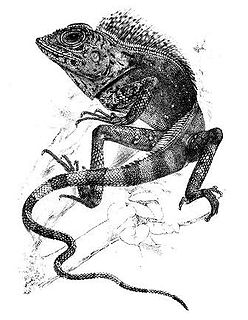
Gonocephalus is a genus of agamid lizards endemic to southeast Asia.

Harpesaurus is a genus of lizards in the family Agamidae. The genus is endemic to Indonesia.

Hydrosaurus, commonly known as the sailfin dragons or Sailfin lizards, is a genus in the family Agamidae. These relatively large lizards are named after the sail-like structure on their tails. They are native to the Philippines, Indonesia and Papua New Guinea, where they are generally found near water, such as rivers and mangrove. Sailfin lizards are semiaquatic and able to run short distances across water using both their feet and tail for support, similar to the basilisks. They are threatened by both habitat loss and overcollection for the wild animal trade.

Carlia is a genus of skinks, commonly known as four-fingered skinks or rainbow skinks, in the subfamily Eugongylinae. Before being placed in this new subfamily, Carlia was recovered in a clade with the genera Niveoscincus, Lampropholis, and others of the Eugongylus group within Lygosominae.

The genus Sphenomorphus – vernacularly known as the common skinks – currently serves as a "wastebin taxon" for numerous skinks. While most or all species presently placed here are probably rather close relatives, the genus as presently delimited is likely to be not monophyletic and is in need of review. Some species in this genus have been moved to Pinoyscincus.
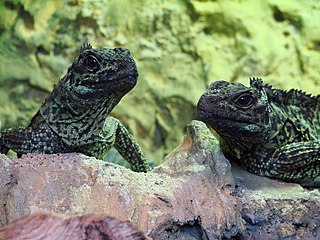
The Amboina sail-finned lizard is a large agamid lizard, growing to over one metre (3.3 ft) in length. It is often confused as and for the largest of the sailfin dragons, however that title belongs to Hydrosaurus microlophus, with the second largest of the sailfin dragons being Hydrosaurus celebensis. It is found in wooded habitats near water in New Guinea and Ambon/Amboina Island (Indonesia). Although it has been reported from the Philippines and Sulawesi, a genetic study have shown that all in the former country are Philippine sailfin lizards H. pustulatus, while genetic and morphological studies have shown that individuals from the latter island belong to two separate species to which the names H. celebensis and H. microlophus are available. Adult male Amboina sail-finned lizards have outer edges of the eyes that are medium-dark clear blue and no nose crest, which are some of the features that separate them from the Sulawesi species.

Boyd's forest dragon is a species of arboreal lizard in the family Agamidae. The species is native to rainforests and their margins in the Wet Tropics region of northern Queensland, Australia. It is the larger of the two species of Lophosaurus found in Australia. Another species, the southern angle-headed dragon, L. spinipes, is found in southern Queensland and northern New South Wales.
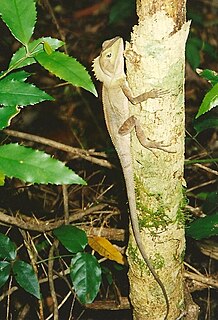
The southern angle-headed dragon or southern forest dragon is a species of agamid lizard endemic to Australia.

Gonocephalus doriae is a species of arboreal lizard in the family Agamidae. The species is endemic to the island of Borneo.
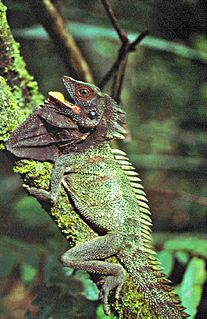
Lophosaurus dilophus, the crowned forest dragon or Indonesian forest dragon, is a large arboreal agamid lizard found in New Guinea and the Moluccan islands, Indonesia.
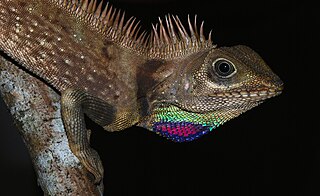
Gonocephalus bellii, commonly known as Bell's anglehead lizard or Bell's forest dragon, is a species of lizard in the family Agamidae. The species is native to Southeast Asia and Oceania.

Lophosaurus is a genus of arboreal agamid lizards from Australia and Melanesia.
Malayodracon is a genus of lizard within the family Agamidae. The genus is monotypic, containing the sole species Malayodracon robinsonii. The species, also known commonly as Robinson's anglehead lizard and Robinson's forest dragon, is endemic to Southeast Asia. No subspecies are recognized as being valid.

Diploderma is a genus of lizards in the family Agamidae. Species of Diploderma are native to Myanmar, China, Vietnam, Taiwan, and Japan. Most of the species are found in China, including many endemics.

Hypsilurus bruijnii, also known commonly as the Bruijn forest dragon, the Bruijni forest dragon, and Bruijn's forest dragon, is a species of lizard in the family Agamidae. The species is native to Indonesia and Papua New Guinea.
Hypsilurus papuensis, the Papua forest dragon, is a species of agama. It is endemic to Papua New Guinea and found in both New Guinean mainland and on the D'Entrecasteaux and Trobriand Islands.

The Makassar sailfin lizard or Sulawesi Giant Sailfin lizard is a species of agamid native to Indonesia. It is the heaviest and longest species of sailfin lizard, making it the largest of all the Agamidae. It is often mistaken for Hydrosaurus amboinensis because of the incorrect information of hydrosaurus amboinensis being the largest of the sailfin dragons.

















